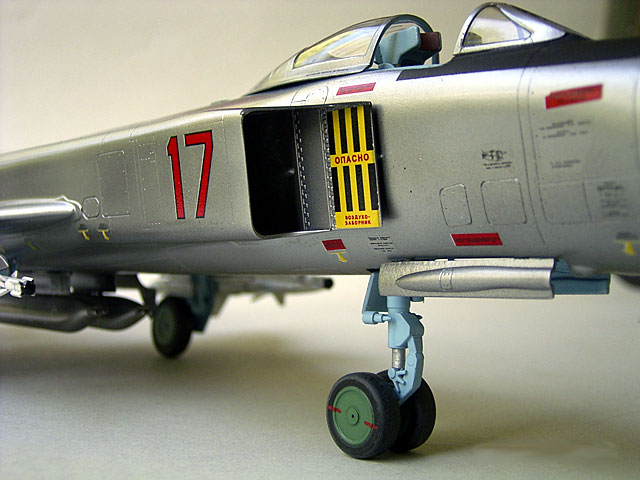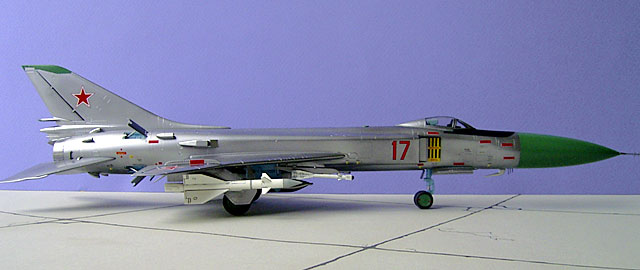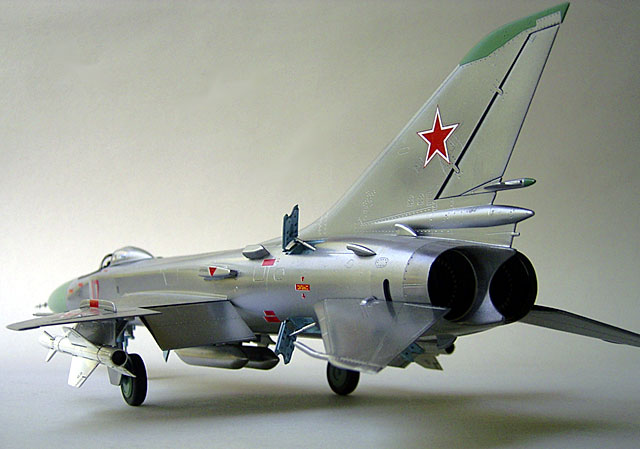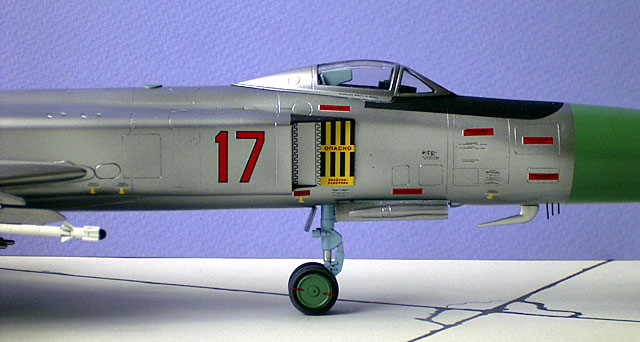|
Sukhoi Su-15TM Flagon F
by Ingo Degenhardt
|

|
|
Sukhoi Su-15TM Flagon F |
images by Lutz Degenhardt

Trumpeter's 1/48 scale Su-15TM Flagon
F is available online from
Squadron.com
The Su-15TM (NATO-Code: Flagon-F)
was the last version of this large single-seat interceptor fighter and
it’s major production version. It appeared in 1973 with the IA-PVO
(Interceptor/Air Defence Force) of the former USSR.
It featured the definitive wing
construction of the series, improved Taifun Radar (TM = Taifun
modifikatsiya), upgraded engines and armament – including two additional
inner wing pylons.
The last production change took place in 1975, when the conical radome
was replaced by one of ogival shape and it is this last version the
Trumpeter Su-15TM represents.

Over 1500 aircraft of all versions
were built when the production ended in the late seventies.
The first thing to do was the correction of the radome angle. The
model’s radome is exactly in line with the fuselage while the real thing
has a downward angle of 3,5 °. This was corrected according to the
drawings found at www.victorymodels (see link below)
I used masking tape to mark the
cutting lines on the fuselage halves.
Building the fuselage is
straightforward with the cockpit tub sandwiched between the halves as
usual, only some internal reinforcements of plastic sheet were used
along the upper and lower fuselage seams as well as for the extra parts
forming the areas for the cockpit and the front wheel well. The purpose
for these parts is that they are simply replaced by different parts for
other versions of the Su-15 (e.g. Two-Seater) This kind of construction
leaves the modeller with quite a lot of seams on the complete fuselage.
The fit of the parts is rather good, but not good enough to avoid some
filling here and there. Some sanding and a good deal of rescribing were
the result.
The reworked forward fuselage
leaves very little attachment points for the large radome, so I cut out
the base for the included Taifun Radar installation (Radome can be build
open) and added some styrene strips to gain more adhesive surface and
thus some more security. (What is worse than breaking of a big part like
a radome during masking/painting?)
Attaching the wings as they fit best to the fuselage sides leaves them
with a remarkable downward angle (Harrier-style). This seems rather
incorrect according to photographs and drawings – so I glued them on
with a much more horizontal appearance and only a little drooping left.
This results in a large gap on the bottom joint of wings/fuselage that
needs lots of filler.
The same goes for the flying
horizontal tail – they droop too much when attached as they fit best,
even though a certain downward angle of some degrees is correct here. It
just has to be reduced a little.
Intakes and vertical tail fit with no problems as well as the rear
section of the fuselage which I supported too with some styrene sheet
inside the fuselage.
The aft fuselage surface is covered
with a multitude of air intakes – the six smaller ones had to be drilled
out as well as the gun pod barrels.
The left wing pitot tube is to be
glued flush onto it’s wing-moulded base. I strengthened this joint by
drilling out both tubes and inserting a short piece of thin wire. The
pitot tube was then attached using cyanoacrylate.

This is my first Trumpeter kit and
I am quite satisfied with it. There are a few unfortunately placed
ejector marks on visible spots (e.g. inner main gear doors) that have to
be filled but it is nothing serious.
All control surfaces are separate parts and can be glued on in any
position. Very good also the extraordinary thin wing fences.
Trumpeter equips their Su-15 with
missiles I (hopefully right) identified as two R-60 (AA-8 “Aphid”) and
each two R-8R (AA-3 “Anab A”) and R-8TM (AA-3 “Anab D”). Of the Anabs,
of course only two can be used, proposed as a mix. The two others are
spares – though without boosters and cable ducts; as there are only two
of each kind...
The boosters suffer from deep
sinkholes and moulding seams that had to be filled and sanded.
Furthermore, there are two GSh-23 gun pods and two external fuel tanks.
I used the twin gun pods for the fuselage stations.
The model was build mostly out of
the box – only seat belts from lead foil and three small antennas on the
underside of the fuselage right behind the radome were added.
This was the first time I used ALCLAD II for painting the biggest part
of a whole model. I prepared the finished fuselage with a coat of Tamiya
acrylic gloss black which was sanded with 1000 wet&dry to further
smoothen the surface. Any plastic primer for acrylic paints could also
be used. (As well as car primer) Unusual was the painting sequence as I
had to paint the ALCLAD first because it would ruin all enamel-painted
areas. Therefore I could not spray the radome first as usual. But it was
masked off and (carefully) used as a handhold. ALCLAD II was sprayed on
according to the detailed instructions provided with the paint bottles
(or: www.alclad2.com)
It is already thinned down for
airbrush use and is easy to spray; the colour used was Aluminium. Good
preparation of the surface which is about to be painted is always
important, but in case of ALCLAD it cannot be overdone. The finished
coat of paint shows every tiny scratch, uneven spots of the base coat or
insufficiently treated seams. I am quite satisfied with the result but
next time I will care even more for a perfect surface to spray on.
The colour itself dries within
minutes and gives a nice aluminium sheen.
As far as I know the Flagons were
painted in a silver colour instead of being left in natural metal, so
the Aluminium might be a little too much on the bright side, but as it
is no highly polished, mirror-like metal sheen, I am satisfied with this
surface. Only the rearmost part of the fuselage seems to be unpainted
metal. This was painted next with Testor’s Exhaust buffing metalizer and
then polished. It shows up a little darker than the aluminium.

Next the anti-glare and walkways on
the front intakes were masked and painted with Humbrol Super enamel
(flat black)
Except for the base coat these
three steps of the painting were all done within one day – thanks to the
extraordinary fast drying time of ALCLAD II. There were no problems with
the removing of the masking tape (Tamiya) as ALCLAD sticks to the base
colour very well an does not lift off at all with the masking tape.
Next step was masking the wheel wells and the recesses for the four
airbrakes. As well as the cockpit, these were painted light blue. After
that, the giant radome and the dielectric panels were masked and sprayed
in XTRA-Color’s X628 (Eastern bloc wheel hub green), slightly lightened
with X629 (Blue/Green interior, Soviet aircraft), a flat color and thus
turning the gloss X628 into semi-gloss. Wheel hubs were sprayed with
that mixture too.
According to the ‘Victory-models’
instructions about the radome changes, not the whole radome kit part was
sprayed green – 3,5mm belong to the fuselage.
As usual with mot of my silver/NM
aircraft, the Flagon did not receive any extensive weathering but only
very few streaks from various covers, etc. made from pastel chalk
powder. So the aircraft is shown in a rather new and pristine condition.
Decals
Trumpeter’s Su-15 contains the
largest amount of decals I ever had to apply to a Soviet aircraft. They
detach fast and easily from the paper but are prone to splitter into
small pieces. This luckily happened only to some of the smaller
stencils. The decals react only very reluctantly to Set & Sol and
repeated treatments were necessary for the red stars until finally the
panel lines underneath were visible again. The usual wrinkling does not
occur at all.

This model was not intended for a
final clear coat, but I did not dare to leave the decals without any
protection, so I cut several patterns into a piece of paper, matching
the used decal sizes – for the national insignia I cut out a star of the
size of the decal. Then all decals received a light and
low-pressure-sprayed coat of Testor’s “Sealer for metalizer”
Trumpeter offers decals for two
versions of the Su-15, one camouflaged and one in silver – my choice.
“Red 17” is believed to be the aircraft flown by the hapless pilot that
shot down Korean Air Lines Flight No. KAL 007 over Sachalin on September
1st , 1983, mistaking the B747 for a US spy plane.
Sources and
Acknowledgements
|
Click on the thumbnails
below to view larger images:
[file:///C:/Documents and Settings/Owner/My Documents/My Webs/features03/photogallery/photo31130/real.htm]
Images and Text Copyright © 2003 by
Ingo and Lutz Degenhardt
Page Created 14 November, 2003
Last Updated 17 March, 2004
Back to HyperScale
Main Page
|
Home |
What's New |
Features |
Gallery |
Reviews |
Reference |
Forum |
Search